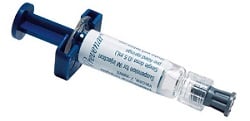 |
We're accustomed to the fact that U.S. payers shell out more for drugs and vaccines than payers in other countries that have cost-conscious government gatekeepers. But a new analysis by The New York Times shows that, in the vaccines market, pricing is even more schizophrenic than that.
Unfortunately for Pfizer ($PFE), the Times made its blockbuster Prevnar 13 shot its case in point. For instance: Two doctors in the same city can pay wildly different prices for Prevnar. So wildly different, in fact, that a large San Antonio, TX, practice was profiting by $39 on each dose of Prevnar 13, while 11% of practices there were losing money.
That variance in price isn't usually visible, the Times says, because Pfizer makes physicians sign non-disclosure agreements to keep individual costs secret.
What's worse, for doctors at least, is that overall, vaccine prices have skyrocketed, with the Centers for Disease Control and Prevention's five recommended childhood shots costing $937 per kid this year, compared with $215 in 1986--after adjustments for inflation. Some solo practice doctors--who typically pay higher prices for vaccines, the NYT says--have simply stopped vaccinating, because acquiring the shots up front is too expensive.
Back to Prevnar 13: Each dose of the pneumoccocal disesase vaccine has a list price of $136. In the U.S., kids are required to get four doses before starting school. Tot that up over the millions of new kindergarteners each year, and you get some hefty revenue. The shot brought in almost $4 billion for Pfizer last year.
The price for Prevnar 13 has gone up by 6% each year since its FDA approval in 2010, the NYT says. It's the world's best-selling vaccine, measured by revenue, according to FierceVaccines research.
Pfizer isn't the only vaccine maker looking to amp up sales by developing newer, higher-priced jabs. For instance, GlaxoSmithKline ($GSK), Sanofi ($SNY) and AstraZeneca ($AZN) are all planning to roll out flu shots that protect against four strains of the virus, rather than three, and they're expecting to sell them at a premium.
And there are good reasons for price hikes on existing shots, too. Vaccines are more complicated--and expensive--to develop and to manufacture than ever. A Pfizer spokeswoman told the Times that vaccine plants cost $600 million to build and one batch of Prevnar 13 takes two years of work. Developing its predecessor, Prevnar 7, took 14 years, she said.
But there's also the fact that vaccine makers have little competition for certain products, and because they're required by the CDC, insurers have to cover them. That requirement itself can boost a price, the Times says, quoting a Brandeis University researcher who advised the Singapore government on its official vaccine schedule. There, Prevnar 13 cost $80 per dose until the government added it to that schedule. The next day, it cost $120, the researcher said.
Just as with other recent debates about pricey pharma products, the cost of vaccinations begs this question: How much is enough? At what point have drugmakers recouped their costs and covered a fair share of R&D for other up-and-coming products?
"It's a risky business developing vaccines, so you can explain--if not necessarily justify--the higher costs of vaccination," Dr. Alan Hinman, a former head of the CDC's immunization division and now a public health scientist told the Times. "A more difficult question is, after the research and development costs are recouped, why don't prices come down?"
That last question is one that private payers may start to ask about vaccines. They're already up in arms about the cost of treating hepatitis C with next-gen drugs, such as the super-turbocharged Sovaldi, which brought in more than $2 billion for its first few months on the market. Pricey cancer drugs are in their sights as well. With lifesaving treatments costing more all over--and the U.S. government unable to dictate prices--for-profit insurers may do the job themselves.
- read the NYT story
Special Reports: Top 10 best-selling vaccines of 2013 | 10 big brands keep pumping out big bucks, with a little help from price hikes